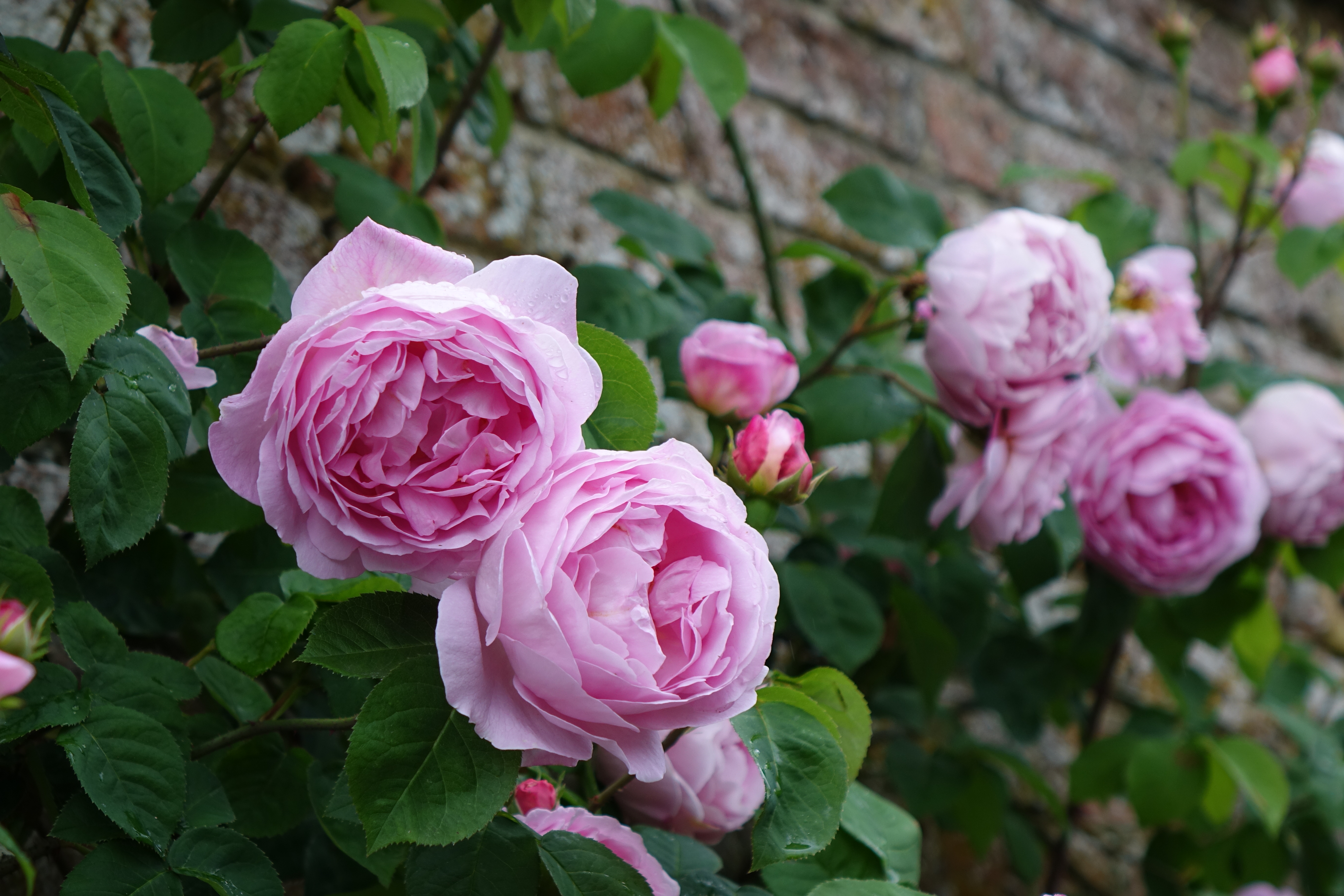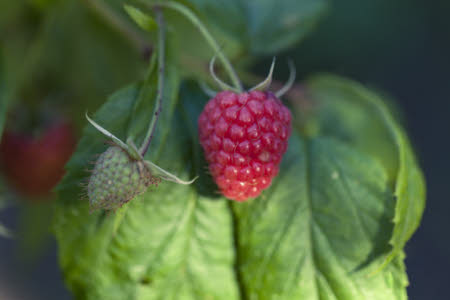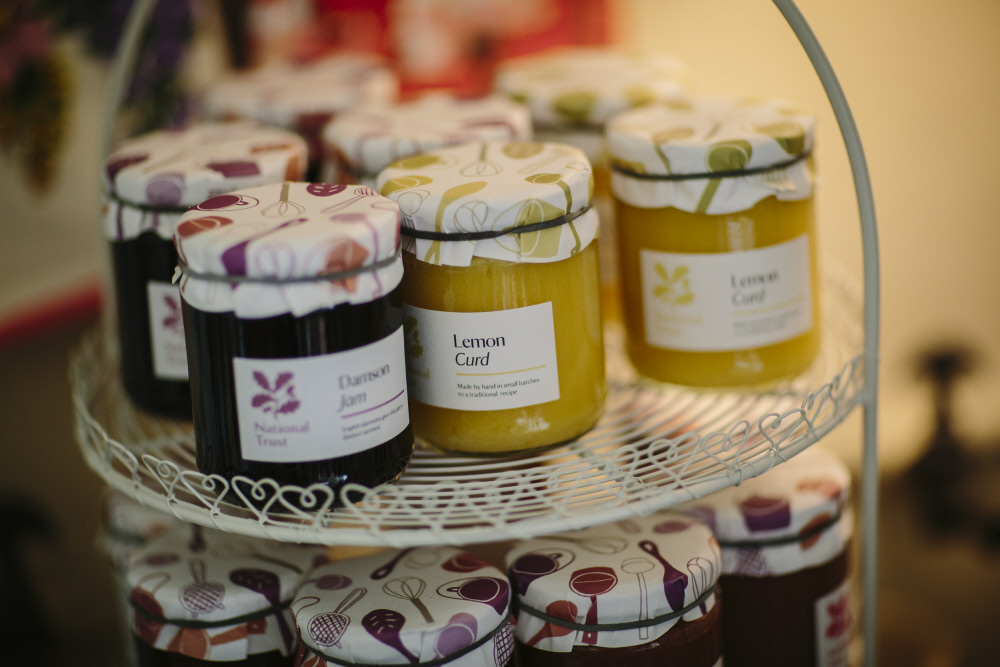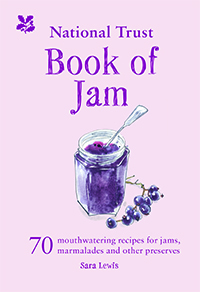With still a few days left to dream about an English summer, we encourage you to try out a few recipes from a new book on jam-making from the National Trust. From Gooseberry Curd to Rose Petal Jelly to a Traditional Red Berry Jam, National Trust Book of Jam by Sara Lewis has something for everyone.
Rose Petal Jelly
This fragrant jelly captures the beauty of an English rose garden. Pick the rose petals on a dry sunny day, from roses with a deep perfume, ideally with a deep color too. Shake the flowers gently to remove any insects, then tear off the petals and snip off the white point from the base of the petals if large. Lightly pack the petals into a measuring jug, being careful not to bruise them.
To finish the jelly add more rose petals, with the white bases snipped off. Leave whole if they are small or chop so that the jelly is speckled with bursts of colour. Leave the jelly to stand before potting so that the petals don’t float to the top. If they do rise in the jars, stir gently with a skewer. This jelly is delicious spooned on to small pieces of toast or to add a floral touch to rice pudding.

Makes 2 jars.
Ingredients:
- 600ml rose petals, plus 300ml to finish, left whole, sliced or chopped
- 700ml cold water
- 450g jam sugar with added pectin
- 2 tbsp freshly squeezed lemon juice
Method:
- Add 600ml rose petals to a bowl, pour over the cold water then cover with a saucer so that the petals stay beneath the level of the water. Leave in a cool place to infuse for 4–6 hours.
- Soak a square of muslin or clean tea towel in a bowl of boiling water for a few minutes to sterilize it, then drain and use to line a sieve set over a measuring jug. Strain the rose petals through the sieve: you should have 600ml of rose-scented water; top up with extra water if necessary.
- Pour the rose water into a preserving pan, bring just to the boil, then add the sugar and lemon juice, and cook over a low heat, stirring from time to time, until the sugar has completely dissolved. Bring to the boil and boil rapidly for 7–10 minutes, stirring from time to time and skimming as needed, until setting point is reached.
- Turn off the heat and add the remaining rose petals, gently turning in the hot jelly. Leave to stand for 10 minutes to thicken slightly. Ladle the jelly into warmed sterilized jars right to the top, then screw on lids or cover with waxed discs and cellophane tops secured with elastic bands.
- Leave to cool, then label and date. Store in a cool place.


Raspberry bush at Oxburgh Hall, Norfolk.
Raspberries
Cultivated in Britain since the seventeenth century, raspberries belong to the same family as the blackberry and the rose. Each raspberry is made up of around 100 drupelets, containing juicy pulp and a seed.
The ancient Romans believed that raspberries had medicinal properties and modern midwives still advise pregnant women to drink raspberry leaf tea to speed up the second stage of labor.
Once picked, raspberries do not continue to ripen and are highly perishable. In Victorian and Edwardian times, the head gardeners of big houses had their work cut out as raspberries became increasingly popular for cordials, fruit vinegars, refreshing soft drinks, desserts
and sauces.
In a bid to impress their employers and neighboring estates new fruits began to appear. The loganberry is a cross between a raspberry and a blackberry, the boysenberry is a cross between a red raspberry, blackberry and loganberry, while the nessberry is a cross between a dewberry, raspberry and blackberry. These varieties unfortunately are not available in the shops but can be grown in the garden at home.
In the 1950s the very best raspberries came from Scotland; they were transported down to London on a steam train known as ‘The Raspberry Special’. Although we think of raspberries as always being red, there are over 200 varieties, some of which are pale yellow, gold, purple and black, with gold being the sweetest.

Red Berry Trio Conserve
Jam making is a good way to use produce from the garden or allotment. But what if you don’t have either? This recipe is based on supermarket packs of fruit. Raspberries and strawberries seem to be available all year round with imported crops; look out for home-grown red berries from mid-May onwards.
Rich in pectin and natural fruit acids, gooseberries make a great partner for lower pectin red summer berries. Green gooseberries are generally in the shops from June onwards, but to maintain the lovely deep red of this conserve, seek out sweeter red gooseberries; you may find them in some supermarkets or local farmers markets.
Makes 5 jars.
Ingredients:
- 450g red gooseberries, topped and tailed
- 100ml water
- 800g strawberries, hulled and quartered or chopped if very large
- 250g raspberries
- 1.1kg preserving sugar
- 15g unsalted butter (optional)
Method:
- Add the gooseberries and water to a preserving pan, bring the water just to the boil then cover and cook over a low heat for 20–25 minutes until the gooseberries are very soft. Crush any large berries with a potato masher if needed.
- Mix in the strawberries and raspberries then add the sugar. Cook over a low heat, stirring from time to time, until the sugar has completely dissolved.
- Bring to the boil and boil rapidly for 10–15 minutes, stirring from time to time, until setting point is reached.
- Skim off the scum then take the pan off the heat and stir in the butter to disperse any remaining scum, if needed. Ladle the hot jam into warmed sterilized jars right to the top, then screw on lids or cover with waxed discs and cellophane tops secured with elastic bands.
- Leave to cool, then label and date. Store in a cool place.


Jam for sale at Allan Bank and Grasmere, Cumbria.
Gooseberry Curd
Acidic fruits such as gooseberries work well in fruit curds but they must be cooked and sieved first to remove their tiny seeds. When cooked, gooseberries lose a little of their color. You can stir in a drop or two of green food coloring to enhance the color (use red food coloring if you have red gooseberries), but this is optional and best stirred into the thickened curd just before potting.
Makes 2 jars.
Ingredients:
- 300g gooseberries, topped and tailed
- Finely grated zest and juice of 1 lemon
- 4 tbsp water
- 115g unsalted butter, diced
- 400g caster sugar
- 4 eggs, beaten
Method:
- Add the gooseberries, lemon zest and juice and water to a saucepan, cover and cook over a low heat for about 15 minutes until the fruit is soft. Leave to cool slightly.
- Purée the gooseberries and lemony juices in a food processor or blender, then press through a sieve set over a bowl and discard the seeds.
- Set a heatproof mixing bowl over a saucepan of simmering water so that the water doesn’t touch the base of the bowl, or transfer the gooseberry purée to a double boiler if you have one. Add the butter and sugar and heat, stirring from time to time, until the butter has melted and the sugar has begun to dissolve.
- Strain the eggs through a sieve into the gooseberry mix and stir well. Cook for 40–50 minutes, stirring from time to time, until the curd has thickened. Ladle the hot curd into warmed sterilized jars, add a waxed disc and a cellophane cover and secure with an elastic band.
- Leave to cool, then label and date. Store in the fridge and eat within 2 weeks.
Variation:
The same weight of prepared cooking apples can be used instead of gooseberries, adding a little freshly grated ginger or chopped stem ginger (drained of its syrup) for extra flavor. Or try
with cooked cranberries – frozen ones work fine – with a little orange juice, or a mix of raspberries and red grapefruit juice.

Buy the Book
 In the latest book in this bestselling series, food writer and cook Sara Lewis brings together 70 mouthwatering recipes for jams, marmalades and preserves. There are recipes sourced from National Trust properties, making the most of their seasonal produce from their kitchen gardens. Enjoy the Oxford marmalade enjoyed by Churchill at Chartwell, or rose geranium and orange jelly made with fruit from the orangery at Saltram.
In the latest book in this bestselling series, food writer and cook Sara Lewis brings together 70 mouthwatering recipes for jams, marmalades and preserves. There are recipes sourced from National Trust properties, making the most of their seasonal produce from their kitchen gardens. Enjoy the Oxford marmalade enjoyed by Churchill at Chartwell, or rose geranium and orange jelly made with fruit from the orangery at Saltram.
The book includes advice on how to grow your own fruit, the best way to use up gluts from the garden and how to achieve the perfect consistency. There are also fun bits of trivia about jam throughout history and in literature. The perfect gift book for any jam-maker.



